This website requires you to be 21 years or older to enter. Please confirm your age below to continue.
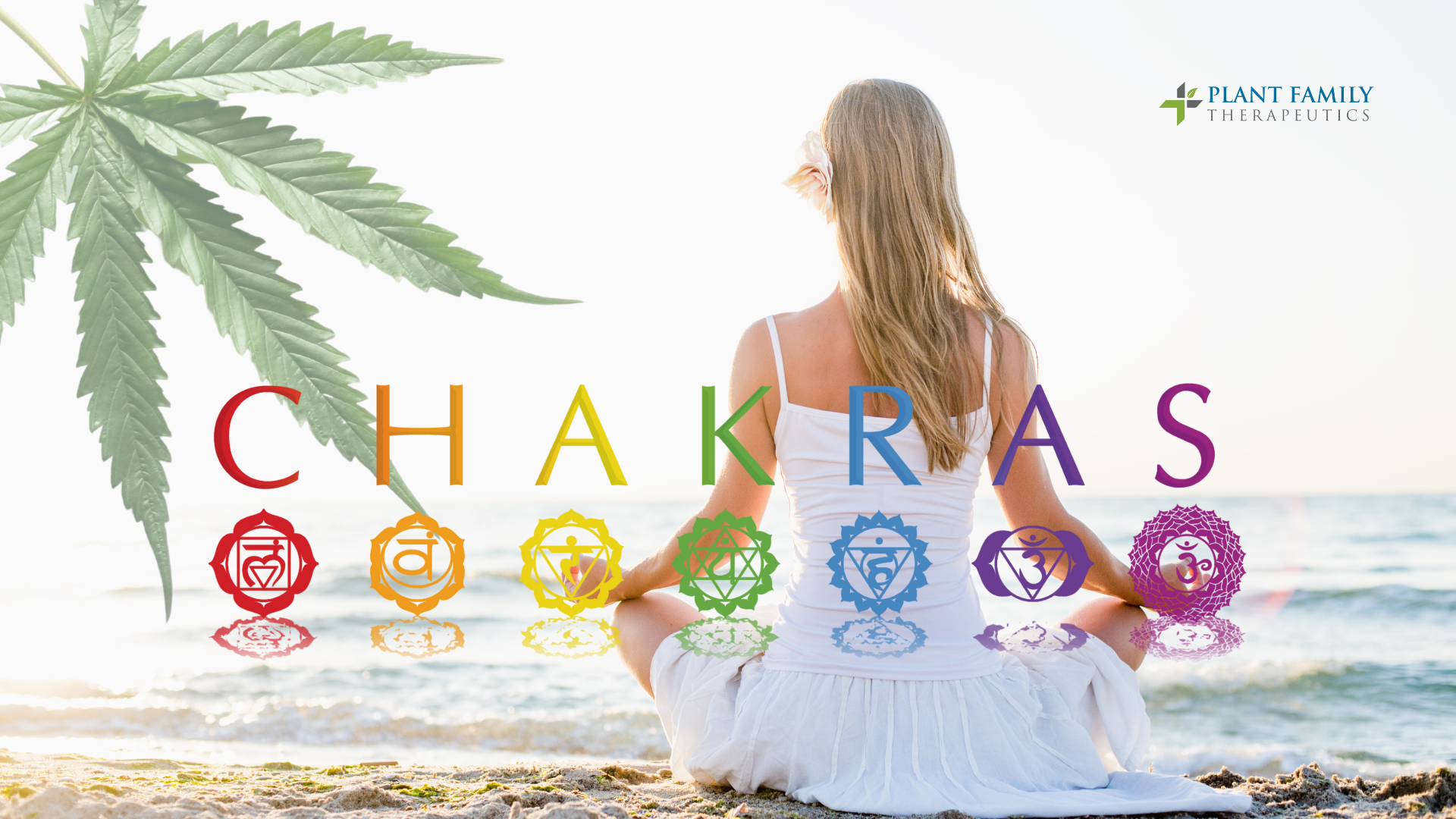
August 2023 by Sandy Yanez
Cannabis, like many mind-altering herbs, has been used in spiritual healing and rituals for thousands of years. It has strong origins in Hinduism, Islam, Rastafarianism, and indigenous cultures throughout Asia, Africa, and other parts of the world.
Through research we now know that balancing your endocannabinoid system is key to healing, but there is more going on inside of you during this healing. Your body is releasing trapped energy and this energy presents itself in many ways including anger, pain, depression, inflammation, and more.
If you have had a consult with me, you’ve probably heard me say how cannabis is a balancing herb that has the ability to heal. You may also have heard me talk about how part of this healing is the internal balancing of your energy. When our energy is out of balance there is a dis-ease present within us that if left unattended to will manifest in the form of symptoms – which is the blocked energy being brought to your attention. When this energy is left to manifest, it becomes disease and illness in the body and mind.
Good Vibes
The use of cannabis can be dated back to 2000 BC when the ancient central and south Asian populations used it to view reality from a different perspective by altering one’s state of mind.
According to the shamans, the cannabis plant has “frequencies” that could open or expand the mind allowing consumers to learn new ways of thinking and being, as well as teaching oneness, inhibition, communication, acceptance, letting go, and the effortlessness of being. Buddhism, Hinduism, and Islam are just a few of the many religions and cultures that utilized cannabis in their spiritual teachings and, more specifically, in meditation.
Many factors play a role in the way you feel from cannabis including the amount consumed, strain, smoking versus eating an edible, your set and setting, and so on. A big factor is our uniqueness. We are unique individuals and because of that cannabis can affect everyone differently. This variation can be explained in terms of “vibrations.” Vibrations are frequencies that are specific to you and interact particularly with the mental effects of cannabis. These vibrations have a strong connection to both your conscious and subconscious, as well as your personality type.
For instance, if someone is in a sad mood (low vibration), cannabis may increase their mood or feeling to a more positive and happy state of mind (higher vibration).
Energy system
Chakra (Chuck-ruh) is a Sanskrit word that means “circular” or “wheel.” The chakras are nonphysical centers of energy. They are part of the electromagnetic energy field that extends beyond the physical body which controls the circulation of subtle energy (prana, qi, or “vital life force”) throughout the human body.
The Chakras originated in India between 1500 and 500 BC and are documented in texts called the Vedas. Knowledge of the chakra system was passed down through tradition by the Indo-European people, also called the Aryan people.
There are seven ‘main’ chakras along the spine, though there are as many as 114 all over the body. The seven energy portals move clockwise or counterclockwise to ensure a consistent flow. The movement can be either upward or downward and helps heal the body to achieve balance (homeostasis). The health of one’s chakras is directly connected to the health of the physical body, the mind, and the emotional well-being of a person.
The Chakra system was traditionally an Eastern philosophy until New Age authors resonated with the idea and wrote about
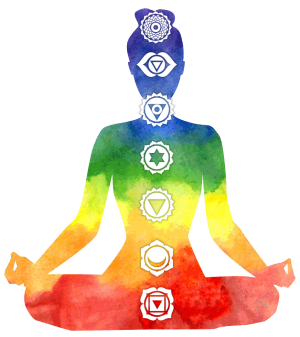
the chakras, expanding upon the older texts adding music tones, crystals, aromatherapy, and activities to activate or open the chakras for optimal healing.
Cannabis & Energy
In Ayurvedic and Traditional Chinese medicine, it is believed the trapped energy can be released through breathing techniques and movement. Meditation, chanting, music, colors, foods, and herbs including cannabis are used to open the blocked energy to allow healing.
Cannabis actually has both negative and positive effects on your chakras. Constant consumption of cannabis lowers your Prana (“life force energy”) because THC enhances receptors in your body that make you feel great at the moment but at the same time it will use a lot of your energy to create this feeling. The more cannabis you consume, the more energy you spend and the less Prana you have.
But a passive consumption of cannabis can have a positive impact on your chakras when used properly. Like when some athletes consume cannabis after a workout to reduce the physical and emotional stress caused by the workout.
Some individuals may have a distorted view of cannabis because they personally have not benefited from or understood the potential power of the plant. For those who have the right vibrations for cannabis along with an understanding of how to control your high, you can use cannabis to have a positive influence on your life and bring awareness to your healing.
In this article, I will be addressing the seven chakras on a basic level, their positive and negative aspects, and offer suggestions on how to open them for healing.
The Root Chakra is the foundation of the physical structure of the body. The word Muladhara is composed of two Sanskrit words, mula meaning “root” and adhara which means “base” or “support.”
The energies of the Root Chakra help in recognizing our strong connection to the earth. It relates to our basic, primal needs of survival, stability, and support, and represents the structure of our body, bones, flesh, and skin. By keeping yourself rooted to your inner self, positivity, and happiness will spread in your life.
Location: Base of spine, pelvic floor
Governs: Feet, legs, bones/teeth, large intestine, adrenal glands, prostate gland, rectum, lowest back, nerves, blood, and immune system.
Associated: Foundations of survival: food, shelter, safety, comfort, and belonging.
Element: Earth
Sound: LAM (llAAmm)
Color: Red
Music: C chord, 396 Hz and 432 Hz frequencies
Mantra: “I am”
Crystals: Garnet, Black Tourmaline, Bloodstone, Hematite, Smoky Quartz, Black Onyx, and Red Jasper.
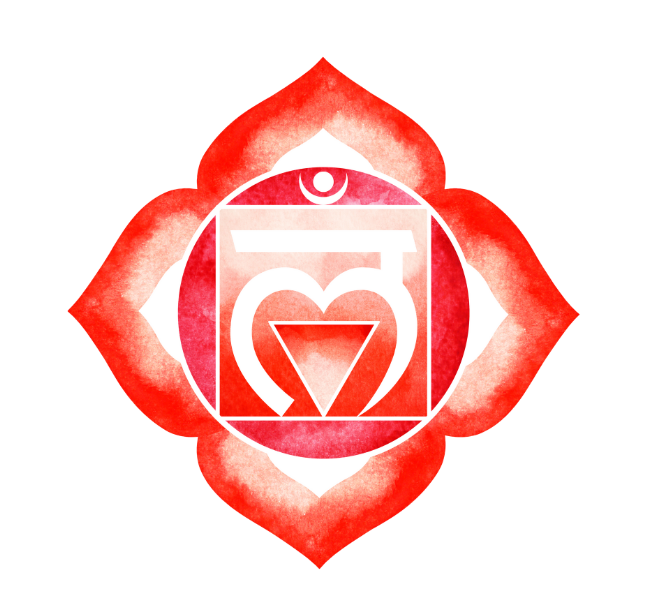
Yoga poses: Corpse, Uttanasana, Garland, Childs, and Tree poses.
Aromatherapy: Cedarwood, Patchouli, Frankincense, Vetiver, and Lavender.
Cannabis/Terpenes: Pure Indica or Indica dominant strains containing Linalool (dominant), Myrcene, and Caryophyllene. You want to be grounded so a strain that is earthy, relaxing, and lightly sedating for you may work best here.
Suggestions: Grand Daddy Purple, OG Kush, Afghani, Kool Whip, Burkle, and Royal Wedding.
Your nose knows, so choosing a strain in each chakra area that resonates with you will give you the best results. (This will be true with all chakra strains suggestions).
Consume your cannabis outdoors where you can notice the beauty and perfection of the natural world. Walking barefoot, sitting under a tree, or gardening will help you ground. This energy can put you in a better psychic rapport with creation and earth. Practice forgiveness.
Muladhara at a glance
Balanced
Underactive
Overactive
The sacral chakra is the second energy center and is associated with pleasure and joy. In Sanskrit, Svadhisthana translates to two Sanskrit words, sva meaning “self”, and adhishthana meaning “established.”
This energy assists in letting go, accepting change, and transformation in life. It is also a direct line to our creativity, intuition, and sexual pleasure. An open flow of energy in this area will allow one to feel dynamic, stimulated, and confident.
Location: Lower abdomen, four fingers below the navel.
Governs: Circulation, bladder, kidneys, reproductive organs, PMS/menopause, low back, hips, and joints.
Associated: Sexuality, creativity, inspiration, desires, intuition, emotions, expression of self.
Element: Water
Color: Vibrant Orange
Sound: VAM (vvAAmm)
Music: D chord, 417 Hz and 480 Hz frequencies
Mantra: “I feel”
Crystals: Carnelian, Snowflake Obsidian, Orange Calcite, Citrine, Sunstone, Tigers Eye, and Amber.
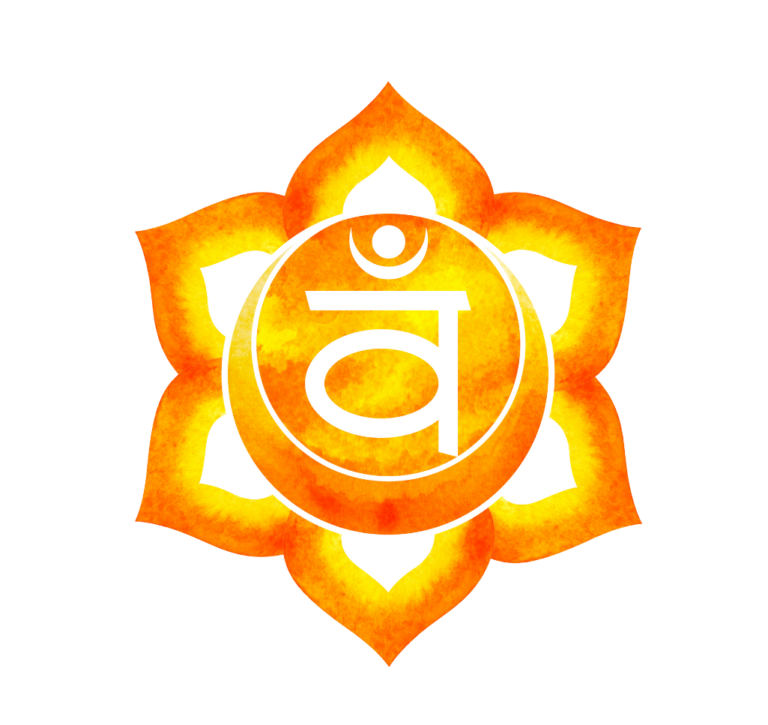
Yoga poses: Goddess, Reclining Bound Angle, Pigeon, Bow, and Low Lunge poses.
Aromatherapy: Ylang-Ylang, Lemon, Clary sage, Patchouli, Bergamot, Sweet orange, Rose, and Sandalwood.
Cannabis/Terpenes: Indica hybrid strains that are calming and relaxing containing Caryophyllene (dominant), Myrcene, Ocimene, and Limonene that have a fruity scent and induce joy, uplifted mood, a reason to move without stimulation, and creativity would work best here.
Suggestions: Apple Fritter, Banana Daddy, Kush Mints, and Cookies.
Get in touch by spending time outside near or in water. Water that moves generally provides a sense of pleasure and adventure, just what this chakra wants. If getting out is not possible, a step in the right direction may be a nice warm bath with essential oils and some music.
Svadhishthana at a glance
Balanced
Underactive
Overactive
The third energy center of the body is the Manipura Chakra or the Solar Plexus Chakra. In Sanskrit, mani means the “shining gem” and pura means “the place”, so Manipura translates to “place of shining gem”.
The Manipura Chakra spreads the fire element in your body which brings energy, warmth, and light. This is also the energy center of digestion. Intellect, ego, willpower, and aggression are also common qualities of the third chakra.
Location: Four fingers above the navel, just below the rib cage, stomach area.
Governs: Our energy, Adrenal glands, Stomach, Intestines, Gallbladder, Pancreas, Respiratory, Trauma, Endocrine.
Associated: Personal power, self-esteem, decision-making, ego, intellect, willpower, aggression, addiction, and transformation.
Element: Fire
Color: Yellow
Sound: RAM (rrAAmm)
Music: E chord, and 528 Hz frequency
Mantra: “I can”
Crystals: Citrine, Amber, Yellow Jasper, Yellow Topaz, Sunstone, Tigers Eye, and Pyrite.
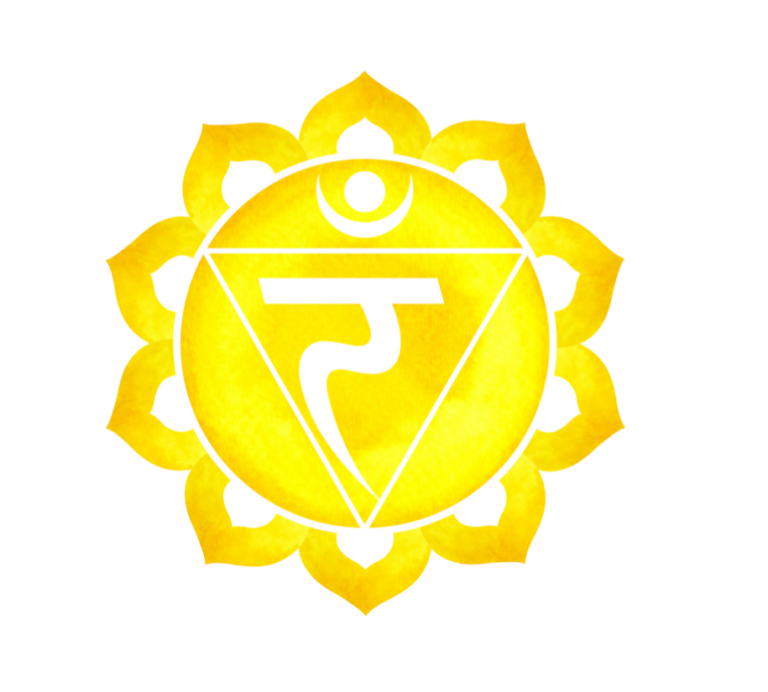
Yoga poses: Boat, Warrior 1, Seated Spinal Twist, and Seated Forward Bend poses.
Aromatherapy: Jasmine, Lemon, Rosemary, Black pepper, Ginger, Atlas Cedarwood, Spearmint, Ylang-Ylang, and Lemongrass.
Cannabis/Terpenes: Hybrid strains for attention and focus yet still chill in nature and contain Limonene (dominant), Caryophyllene, and Myrcene may work best here.
Suggestions: Cherry Garcia, Kush Mints, Queen Mother Goji, and Holy Roller.
Break out of your routine and make a change. Routines only tend to perpetuate our feelings of powerlessness. Get outside and get moving with some yoga, Tai chi, or a brisk walk. Allow the sun to shine upon you and be the place of shining gem while bringing in the energy, warmth, and light you need.
Manipura at a glance
Balanced
Underactive
Overactive
In Sanskrit, Anahata means “unstuck.” It is the fourth chakra and is often considered the most crucial of the seven chakras. It is the bridge between the upper and lower chakras, balancing the material and spiritual worlds, facilitating our emotional and physical well-being, and allowing us to receive and give love unconditionally.
Location: Center of the chest
Governs: Our heart, arteries, blood flow, circulation, lungs, thymus gland.
Associated: Love, compassion, acceptance, trusting yourself, respect.
Element: Air
Color: Green
Sound: YAM (yyAAmm)
Music: D chord, and 639 Hz frequency
Mantra: “I love”
Crystals: Rose Quartz, Rhodonite, Moldavite, Emerald, Malachite, Green Jade, and Green Aventurine
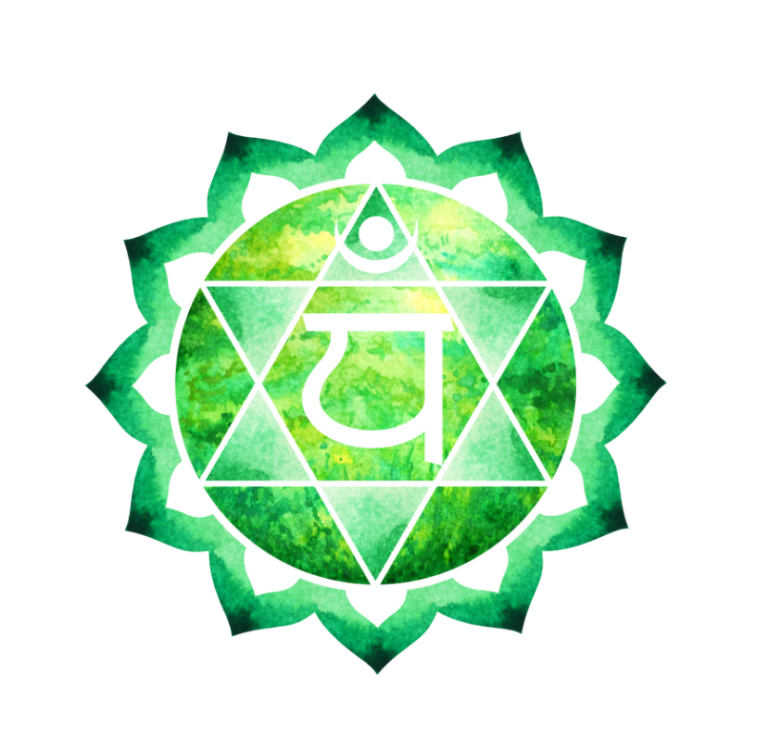
Yoga poses: Camel, Sphinx, Bridge, Cow Face, and Extended Cobra poses.
Aromatherapy: Rose, Rosewood, Geranium, Jasmine, Neroli, Bergamot, and Lemon.
Cannabis/Terpenes: Hybrid strains that you feel balanced with and that put you in a happy, uplifted mindset. Strains that may be optimal should have Limonene closely balanced with Caryophyllene, some Terpinolene, and a splash of Pinene.
Suggestions: Lilac Cookies, Banana Cream Cake x Jealousy, or Chiesel.
Open your heart chakra energy by writing letters to loved ones expressing your gratitude for them, what they have done for you, taught you, make you feel, etc. It does not have to be perfect, and you don’t even have to give it to them. By writing your expressed gratitude for them it will help your heart open so you can move forward in healing.
Anahata at a glance
Balanced
Underactive
Overactive
In Sanskrit, Vishuddha translates to “especially pure.” It signifies the purification of our thoughts, words, and actions, enabling us to embrace our true selves and communicate with clarity, honesty, and compassion.
A balanced Throat Chakra instills a sense of self-assurance and empowerment. It helps dissolve self-doubt and fear of judgment, enabling us to stand in our own power and express ourselves authentically without hesitation. This energy center is intimately linked to our creativity. When balanced, it unlocks our inspiration and allows ideas to flow freely and effortlessly.
Location: Base of the throat, neck
Governs: Throat, neck, larynx, tongue, teeth and gums, jaw, nasal passages, thyroid and parathyroid.
Associated: Expression, communication (including listening), and authenticity.
Element: Ether (space)
Color: Light Blue
Sound: HAM (hhAAmm)
Music: G chord, 672 Hz and 741 Hz frequencies
Mantra: “I speak”
Crystals: Aquamarine, Lapis Lazuli, Sodalite, Blue Calcite, Chrysocolla, Blue Lace Agate, and Turquoise.
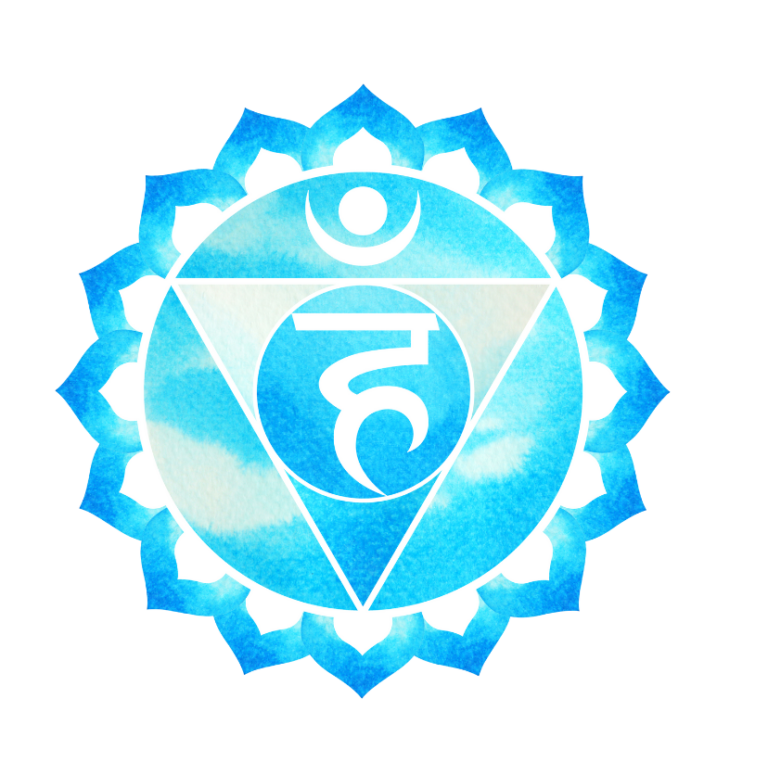
Yoga poses: Fish, Supported Shoulder Stand, Plow, and Lion’s Breath poses.
Aromatherapy: Frankincense, Geranium, Bergamot, Jasmine, Eucalyptus, Sage, and Lavender.
Cannabis/Terpenes: Sativa hybrids dominant with Limonene, producing some clarity with creativity and inducing chatter. You want to be expressive here without mind-racing behavior.
Suggestions: GG4, Strawberry Cough, Lemon Haze, Mimosa, and Pineapple Express.
Sing, laugh, whistle, hum, chant, get loud with your voice! Unlike creativity in the second chakra, the throat chakra’s creativity is more conscious. It’s about your unique self-expression coming from the inside out.
Start a journal – expressing yourself on paper is one of the most beneficial things you can do to release your inner truth. Journaling is one of the best ways to invite spontaneous insight, understanding, and growth into your life – you can dig deep when it’s just you and your pen and heal deeply.
Vishuddha at a glance
Balanced
Underactive
Overactive
In Sanskrit, Ajna means “beyond wisdom,” “perceive,” or “command” and it is the most prominent center of our consciousness, intuition, and perception.
Considered to be the sixth of the major chakras, the third eye chakra helps you perceive a cosmic vision beyond the physical world. It tells us that something exists when only the inner sight can tell us what it is. The third eye chakra witnesses the “internal screen” where memory and fantasy, images and archetypes, intuition and imagination are displayed. From this, we create meaning and consciousness in everyday life.
Location: Just above and between the eyebrows, center of the forehead
Governs: Hypothalamus, pituitary gland, pineal gland, eyes, ears, nose, brain, nervous systems.
Associated: Connects intuition, wisdom, awareness, self-realization, and spiritual communication.
Element: Light
Color: Indigo
Sound: OM (AAUMm)
Music: A chord, 720 Hz and 852 Hz frequencies
Mantra: “I see”
Crystals: Amethyst, Labradorite, Lapis Lazuli, Clear Quartz, Moonstone, Purple Fluorite, Black Tourmaline, and Lepidolite.
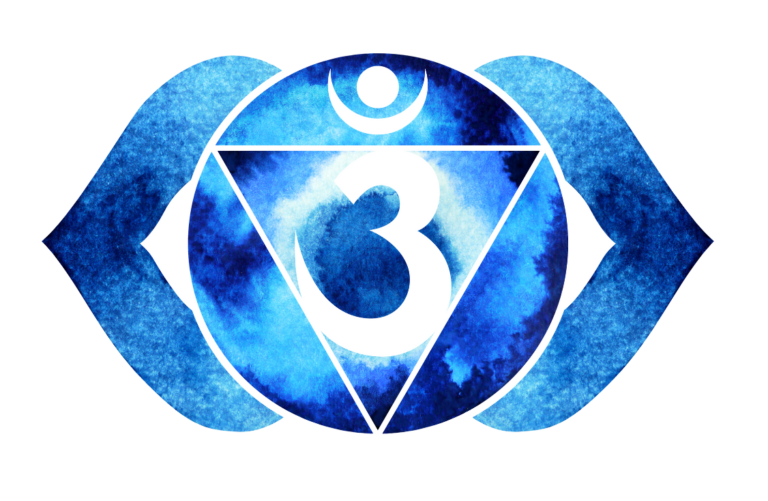
Yoga poses: Headstand, Plow, Child, Downward Facing Dog and Humble Warrior poses.
Aromatherapy: Lemon, Clary Sage, Juniper Berry, Pine, Cypress, Rosemary, Bay leaf, Frankincense, Lavender, Marjoram, Sandalwood, and Roman Chamomile.
Cannabis/Terpenes: CBD to amplify awareness and a Sativa hybrid with Caryophyllene, Ocimene, Limonene, some Myrcene, and euphoria with active energy – not racy but mind-provoking into deep meditative thoughts.
Suggestions: Blue Dream, Pineapple Express, Lemon OG Haze, or Peach Rings.
Learning how to open your third eye takes dedication and the willingness to dig deep and make a few changes in your life. But the effort you put in is well worth it, and the gift of clarity will bless your entire life for years to come.
Move outside your comfort zone and explore alternative beliefs and ideas. Get intellectually curious. Meditate, practice mindfulness, and chant affirmations. Journal your core beliefs of who you are and what you desire in life.
Ajna at a glance
Balanced
Underactive
Overactive
In Sanskrit, Sahasrara means “thousand petaled” and gets its name from the lotus flower with a thousand petals. Each petal represents a different aspect of our being, such as emotions, thoughts, and actions. The complete opening of all the petals causes a universal balance of the body, mind, and spirit.
Located at the crown of the head, the Crown Chakra is the seventh energy center in the chakra system. It is the highest point in the body and acts as a bridge between our physical selves and the spiritual world.
Location: Top of head
Governs: The brain and its functions, the nervous systems, your knowledge, and inner wisdom.
Associated: Our Consciousness
Element: Thought or Light
Color: Violet
Sound: Silence or OM (AAUMm)
Music: B chord, 768 Hz and 963 Hz frequencies
Mantra: “I know”
Crystals: Amethyst, Clear Quartz, Selenite, Lepidolite, Howlite, Labradorite, Moonstone, Lapis Lazuli, Fluorite, and Moonstone.
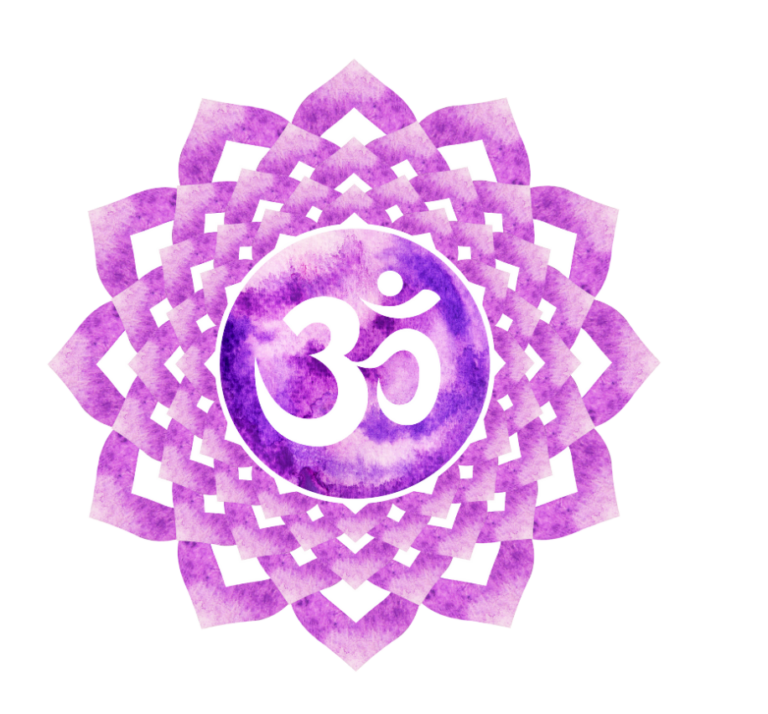
Yoga poses: Headstand, Supported shoulder Stand, Lotus, and Reclining Bound Angle poses.
Aromatherapy: Sage, Mint, Frankincense, Vetiver, and Lotus flower.
Cannabis/Terpenes: Looking for clarity here. CBD allows for mental clarity and focus that is needed. A Sativa that provides mental clarity without anxiety, containing Terpinolene, Ocimene, and a small amount of Myrcene.
Suggestions: Go for strains that have aromas of mint (terpinolene) and sage (ocimene) if possible, otherwise Jack Herer strains that are clarifying, Super Lemon Haze, Strawberry Cough, Durban Poison, and Pineapple Express – they all have Ocimene and Terpinolene in them. These strains are listed as Sativas and can cause anxiety and a racing mind, so to counter these effects keep THC consumption low and use CBD to offset any undesirable effects.
Meditation is one of the best ways to open the Crown Chakra, especially when combined with the bija (a short one syllable word chant) mantra that corresponds to this Chakra, OM. Try meditating outside. Spending time in nature, especially near trees or bodies of water, can help balance this energy center.
Sahasrara at a glance
Balanced
Underactive
Overactive
Wrapping it up
The 7 chakras are powerful points in the energy body that help you maintain a healthy physical and emotional balance in life. For this reason, it’s vital that you observe these energy centers regularly and take time out of your busy day to improve the flow of prana to each. On a deeper level, aligning your chakras can also help you tune into your true Self and unlock the divine power within.
The chakra system provides a map that shows the relationship between anatomy, mindset, emotions, and energy. It exposes the mind-body relationship in an approachable and practical manner. The roadmap serves as a reminder of what our holistic beings require in order to be healthy and happy. The chakra anatomy tells us that we may be grounded yet flexible, passionate yet disciplined, and expressive yet caring.
Awareness to which of your chakras are out of balance is key to aligning them. Our bodies are in constant flux between balance and imbalance. Unless you experience an apparent problem in one area of the body, imbalances can be difficult to detect. That being said, it’s good to bring pure awareness to your body/mind and start understanding its signals and clues so that you can align your chakras. For example, frequent constipation can indicate a blockage in the first chakra. A recurring sore throat leaves clues to a blocked fifth chakra. Frequent headaches around the area of the forehead may mean your sixth chakra is blocked.
When it comes to healing the chakras, it’s wise to start with the root chakra, addressing ideas related to safety, nourishment, belonging, finances, and family. From there, move up the spine to the sacral chakra and so forth. The health of the lower chakras is crucial to the health of the upper chakras, and generally opening from root to crown goes more smoothly.
***NOTES:
Frankincense essential oil (Boswellia carterri) contains the following terpenes: Pinene, Limonene, Myrcene, Caryophyllene, Linalool, and more making it ideal for all chakra healing.
When it comes to cannabis, if you can’t find the strain you’re looking for, try creating it. A distillate or isolate of THC or CBD can be altered just by adding aromatherapy. For instance, Frankincense with its strong terpene profile can add focus form the pinene, relaxed happiness from limonene, body relaxation from myrcene, pain reduction from caryophyllene, and a calm nature from linalool.
Musical tones and/or aromatherapy are quick and easy ways to shift your chakras and can be done almost anywhere at any time.
The yoga videos are showing full poses without modifications. The best practice is to find one that is at your level of experience and remember that it is not the pose but the journey to the pose (strength and growth within) that is rewarding.
You are what you eat so whatever you put into your body will affect your chakras. Eating a rainbow of healthy foods will positively feed your chakras. Red foods for root, yellow for sacral, orange for solar, and so on.
It only takes 10 min a day to make positive changes in your life, and you are worth it!